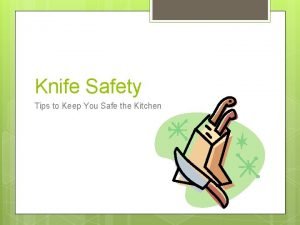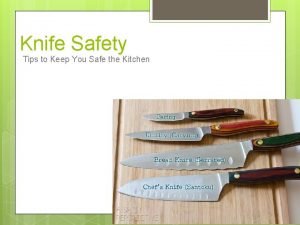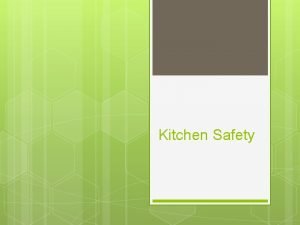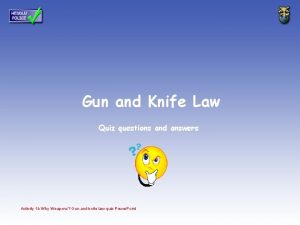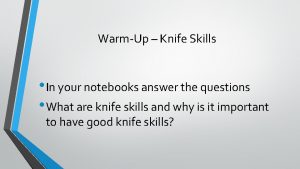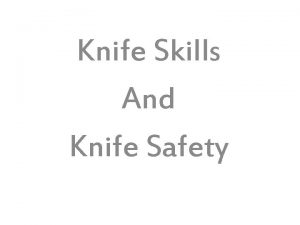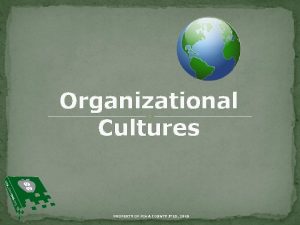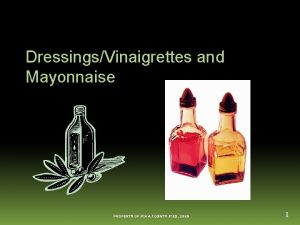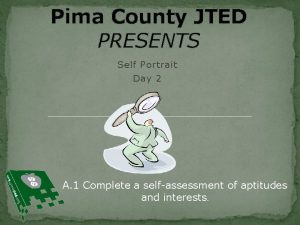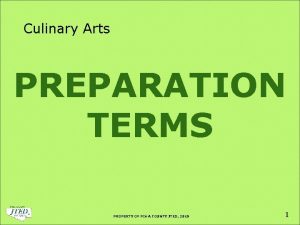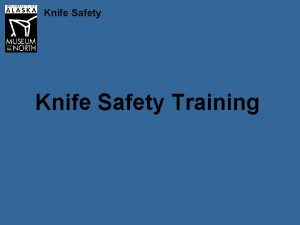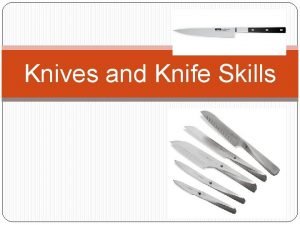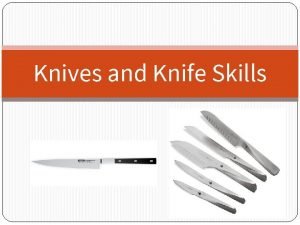Culinary KNIFE SAFETY PROPERTY OF PIMA COUNTY JTED




















- Slides: 20

Culinary KNIFE SAFETY PROPERTY OF PIMA COUNTY JTED, 2010 1

Bellwork 1. What are three common ways people cut themselves with a knife in a kitchen. 2. Take out a piece of paper and write your answer. 3. Be prepared to share your ideas.

Objectives 1. Define terminology 2. Demonstrate proper knife safety 3. Demonstrate proper knife sanitation/cleaning methods 4. Practice proper knife storage

Terminology claw grip – method of holding food during cutting, characterized by curling the fingers inward and gripping the food with the fingernails; the side of the knife blade rests against the first knuckle of the guiding hand, keeping the blade perpendicular to the cutting board and fingers out of harm's way guiding hand – the hand that controls the ingredient being cut anchor – a no-slip mat or damp towel used to prevent the cutting board from slipping

Knife Safety Key Points 1. Stop - make sure no one else is within arm's reach 2. Away - always cut away from your finger or other body parts 3. Sharp - a sharp, clean knife is a safe knife 4. Store - knives closed, in a sheath or knife block PROPERTY OF PIMA COUNTY JTED, 2010 5

How to Hold a Chef’s Knife Click on link for video https: //www. youtube. com/watch? v=20 gwf 7 Ytt. QM

Knife Safety Handling a knife Importance of the grip Provides maximum control over the knife. Increases speed and accuracy. Prevents slipping.

Knife Safety Guiding Hand The hand that controls the ingredient being cut. Claw Grip Method of holding food during cutting Key Attributes Fingers curl inward and grip food with fingernails Knife blade rests against first knuckle of guiding hand Blade remains perpendicular to cutting board

Knife Safety Anchoring Anchor with a non-slip mat or damp towel underneath the board so it does not slip and cause injury.

Rock Cut or Rolling Technique

Up and down - Tap Chop

Cross Chop

Proper Care of Knives Wash Always hand wash knives Never leave your knives in the sink Unseen knives can cause injury Never wash knives in the dishwasher hot water dulls the blade handles can rot rivets can become loose

Proper Care of Knives Sanitize- Wipe down knives during use. Use your sanitation rag/cloth.

Proper Care of Knives Storage Always use a sheath if storing in a drawer; A sheath protects the blade from damage. Knives can also be stored in a knife roll, roll block, block or magnet

Proper Care of knives Types of cutting boards Wooden Resilient (they give a bit as the knife hits) Must be hand washed and sanitized Not allowed in most restaurant kitchens Hard rubber and/or plastic Can be sanitized in the dishwasher Plastic isn’t very resilient and can develop grooves traps bacteria slows your knife down Can dull knife blade over time

Cutting Board Sanitation Always keep your board clean and sanitary. Always wash your board in a three compartment sink to ensure cleanliness. Thoroughly clean and sanitize your area after cutting chicken or other raw products on your board

Cutting Board Storage Always store boards upright with space in between each board Never stack boards

Closure Ticket Out 1. Get out a half sheet of paper. 2. List 4 precautions you should take while handling a knife. 3. Turn in your Ticket Out when you finish.

Quantity Time Uniformity of Product Mise en Safety and Place Sanitation Professional 20 points 2 oz. of each of the seven cuts. Achieved cuts in Standard for 15 minutes or cuts, measured less. to ruler specification. All necessary equipment present and useable. Clean area and equipment. Clean up and sanitized. Adequate 15 points 2 oz. of five of the seven cuts. Achieved cuts in Product uniform All equipment less than 20 in size to the eye. present, but not minutes. useable. Evolving 10 points 2 oz. of four of the seven cuts. Achieved cuts in Product uniform Most equipment Cleaned less than 30 wit in group. present. equipment but minutes. not put away or sanitized. Inadequate 5 points Less than 2 oz. of a variety of cuts. Cuts took longer Product not than 30 minutes. uniform within group. Training 0 points Attempted cutting Practiced cuts exercise. not timed. Cleaned all equipment but didn’t sanitize. Missing equipment. Equipment not cleaned or sanitized. Produced cut but Instructor not uniform. gathered equipment. Instructor cleaned and sanitized area.
 Kitchen knife safety tips
Kitchen knife safety tips Kitchen knife safety tips
Kitchen knife safety tips Kitchen knife safety poster
Kitchen knife safety poster Knife construction worksheet answers
Knife construction worksheet answers Culinary crossword 2.1 fire safety
Culinary crossword 2.1 fire safety Giza cotton vs pima cotton
Giza cotton vs pima cotton David padgett md
David padgett md Pima master gardeners
Pima master gardeners Pima medical institute dress code
Pima medical institute dress code Commutative property vs associative property
Commutative property vs associative property Coparcenary property and separate property
Coparcenary property and separate property Physical properties and chemical properties
Physical properties and chemical properties Polk property appraiser fl
Polk property appraiser fl Hernando county property
Hernando county property Washoe county personal property declaration
Washoe county personal property declaration Bay county property appraisers
Bay county property appraisers Bay county property appraisers
Bay county property appraisers Basic knife cuts chart
Basic knife cuts chart Identify
Identify Swiss knife vs. radio
Swiss knife vs. radio Stretch reflex
Stretch reflex
